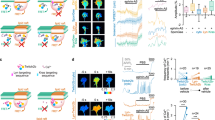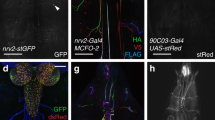Abstract
Plasma membrane potentials gate the ion channel conductance that controls external signal–induced neuronal functions. We found that diffusible guidance molecules caused membrane potential shifts that resulted in repulsion or attraction of Xenopus laevis spinal neuron growth cones. The repellents Sema3A and Slit2 caused hyperpolarization, and the attractants netrin-1 and BDNF caused depolarization. Clamping the growth-cone potential at the resting state prevented Sema3A-induced repulsion; depolarizing potentials converted the repulsion to attraction, whereas hyperpolarizing potentials had no effect. Sema3A increased the intracellular concentration of guanosine 3′,5′-cyclic monophosphate ([cGMP]i) by soluble guanylyl cyclase, resulting in fast onset and long-lasting hyperpolarization. Pharmacological increase of [cGMP]i caused protein kinase G (PKG)-mediated depolarization, switching Sema3A-induced repulsion to attraction. This bimodal switch required activation of either Cl− or Na+ channels, which, in turn, regulated the differential intracellular Ca2+ concentration increase across the growth cone. Thus, the polarity of growth-cone potential shifts imposes either attraction or repulsion, and Sema3A achieves this through cGMP signaling.
This is a preview of subscription content, access via your institution
Access options
Subscribe to this journal
Receive 12 print issues and online access
$209.00 per year
only $17.42 per issue
Buy this article
- Purchase on Springer Link
- Instant access to full article PDF
Prices may be subject to local taxes which are calculated during checkout






Similar content being viewed by others
References
Hille, B. Ion Channels of Excitable Membranes (Sinauer, Sunderland, Massachusetts, 2001).
Gomez, T.M. & Spitzer, N.C. In vivo regulation of axon extension and pathfinding by growth-cone calcium transients. Nature 397, 350–355 (1999).
Goodman, C.S. Mechanisms and molecules that control growth cone guidance. Annu. Rev. Neurosci. 19, 341–377 (1996).
Yu, T.W. & Bargmann, C.I. Dynamic regulation of axon guidance. Nat. Neurosci. 4, 1169–1176 (2001).
Mueller, B.K. Growth cone guidance: steps towards a deeper understanding. Annu. Rev. Neurosci. 22, 351–358 (1999).
Song, H.J. & Poo, M.M. Signal transduction underlying growth cone guidance by diffusible factors. Curr. Opin. Neurobiol. 9, 355–363 (1999).
Tessier-Lavigne, M. & Goodman, C.S. The molecular biology of axon guidance. Science 274, 1123–1133 (1996).
Höpker, V.H., Shewan, D., Tessier-Lavigne, M., Poo, M.M. & Holt, C. Growth cone attraction to netrin-1 is converted to repulsion by laminin-1. Nature 401, 69–73 (1999).
He, Z., Wang, K.C., Koprivica, V., Ming, G.L. & Song, H.J. Knowing how to navigate: mechanisms of semaphorin signaling in the nervous system. Sci. STKE 119, RE1 (2002).
Pasterkamp, R.J. & Kolodkin, A.L. Semaphorin junction: making tracks toward neural connectivity. Curr. Opin. Neurobiol. 13, 79–89 (2003).
Henley, J.R. & Poo, M. Guiding neuronal growth cones using Ca2+ signals. Trends Cell Biol. 14, 320–330 (2004).
Gomez, T.M. & Zheng, J.Q. The molecular basis for calcium-dependent axon pathfinding. Nat. Rev. Neurosci. 7, 115–125 (2006).
Hong, K., Nishiyama, M., Henley, J., Tessier-Lavigne, M. & Poo, M. Calcium signalling in the guidance of nerve growth by netrin-1. Nature 403, 93–98 (2000).
Wang, G.X. & Poo, M. Requirement of TRPC channels in netrin-1-induced chemotropic turning of nerve growth cones. Nature 434, 898–904 (2005).
Ming, G., Henley, J., Tessier-Lavigne, M., Song, H.-J. & Poo, M. Electrical activity modulates growth cone guidance by diffusible factors. Neuron 29, 441–452 (2001).
Henley, J.R., Huang, K.H., Wang, D. & Poo, M.M. Calcium mediates bidirectional growth cone turning induced by myelin-associated glycoprotein. Neuron 44, 909–916 (2004).
Nishiyama, M. et al. Cyclic AMP/GMP-dependent modulation of Ca2+ channels sets the polarity of nerve growth-cone turning. Nature 423, 990–995 (2003).
Shim, S. et al. XTRPC1-dependent chemotropic guidance of neuronal growth cones. Nat. Neurosci. 8, 730–735 (2005).
Song, H. et al. Conversion of neuronal growth cone responses from repulsion to attraction by cyclic nucleotides. Science 281, 1515–1518 (1998).
Ayoob, J.C., Yu, H., Terman, J.R. & Kolodkin, A.L. The Drosophila receptor guanylyl cyclase Gyc76C is required for semaphorin-1a-Plexin A-mediated axonal repulsion. J. Neurosci. 24, 6639–6649 (2004).
Song, H.-J., Ming, G.-L. & Poo, M.M. cAMP-induced switching in turning direction of nerve growth cones. Nature 388, 275–279 (1997).
Ming, G.-L., Song, H.-J., Berninger, B., Holt, C.E., Tessier-Lavigne, M. & Poo, M.M. cAMP-dependent growth cone guidance by netrin-1. Neuron 19, 1225–1235 (1997).
Polleux, F., Morrow, T. & Ghosh, A. Semaphorin 3A is a chemoattractant for cortical apical dendrites. Nature 404, 567–573 (2000).
Hong, K. et al. A ligand-gated association between cytoplasmic domains of UNC5 and DCC family receptors converts netrin-induced growth cone attraction to repulsion. Cell 97, 927–941 (1999).
Stein, E. & Tessier-Lavigne, M. Hierarchical organization of guidance receptors: silencing of netrin attraction by slit through a Robo/DCC receptor complex. Science 291, 1928–1938 (2001).
Ben-Ari, Y. Excitatory actions of GABA during development: the nature of the nurture. Nat. Rev. Neurosci. 3, 728–739 (2002).
O'Dowd, D.K., Ribera, A.B. & Spitzer, N.C. Development of voltage-dependent calcium, sodium, and potassium currents in Xenopus spinal neurons. J. Neurosci. 8, 792–805 (1988).
Nakamura, F., Tanaka, M., Takahashi, T., Falb, R.G. & Strittmatter, S.M. Neuropilin-1 extracellular domains mediate semaphoring D/III-induced growth cone collapse. Neuron 21, 1093–1100 (1998).
Goshima, Y. et al. A novel action of collapsin: collapsin-1 increases antero- and retrograde axoplasmic transport independently of growth cone collapse. J. Neurobiol. 33, 316–328 (1997).
de la Torre, J.R. et al. Turning of retinal growth cones in a netrin-1 gradient mediated by the netrin receptor DCC. Neuron 19, 1211–1224 (1997).
Zecevic, D. Multiple spike-initiation zones in single neurons revealed by voltage-sensitive dyes. Nature 381, 322–325 (1996).
Zheng, J.Q., Felder, M., Connor, J.A. & Poo, M.M. Turning of nerve growth cones induced by neurotransmitters. Nature 368, 140–144 (1994).
Chen, C.K. The vertebrate phototransduction cascade: amplification and termination mechanisms. Rev. Physiol. Biochem. Pharmacol. 154, 101–121 (2005).
Toyofuku, T. et al. FARP2 triggers signals for Sema3A-mediated axonal repulsion. Nat. Neurosci. 8, 1712–1719 (2005).
Terman, J.R. & Kolodkin, A.L. Nervy links protein kinase A to Plexin-mediated semaphorin repulsion. Science 303, 1204–1207 (2004).
Behar, O., Mizuno, K., Badminton, M. & Woolf, C.J. Semaphorin 3A growth cone collapse requires a sequence homologous to tarantula hanatoxin. Proc. Natl. Acad. Sci. USA 96, 13501–13505 (1999).
Shewan, D., Dwivedy, A., Anderson, R. & Holt, C.E. Age-related changes underlie switch in netrin-1 responsiveness as growth cones advance along visual pathway. Nat. Neurosci. 5, 955–962 (2002).
Campbell, D.S. et al. Semaphorin 3A elicits stage-dependent collapse, turning, and branching in Xenopus retinal growth cones. J. Neurosci. 21, 8538–8547 (2001).
Huber, A.B., Kolodkin, A.L., Ginty, D.D. & Cloutier, J.F. Signaling at the growth cone: ligand-receptor complexes and the control of axon growth and guidance. Annu. Rev. Neurosci. 26, 509–563 (2003).
Guirland, C., Suzuki, S., Kojima, M., Lu, B. & Zheng, J.Q. Lipid rafts mediate chemotropic guidance of nerve growth cones. Neuron 42, 51–62 (2004).
Togashi, K. et al. Cyclic GMP-gated CNG channels function in Sema3A-induced growth cone repulsion. Neuron (in the press).
Patel, N.B. & Poo, M.M. Perturbation of the direction of neurite growth by pulsed and focal electric fields. J. Neurosci. 4, 2939–2947 (1984).
Zheng, J.Q. Turning of nerve growth cones induced by direct focal elevation of intracellular Ca2+ concentration. Nature 403, 89–93 (2000).
Spitzer, N.C., Kingston, P.A., Manning, T.J. Jr & Conklin, M.W. Outside and in: development of neuronal excitability. Curr. Opin. Neurobiol. 12, 315–323 (2002).
Crair, M.C. Neuronal activity during development: permissive or instructive? Curr. Opin. Neurobiol. 9, 88–93 (1999).
Hanson, M.G. & Landmesser, L.T. Normal patterns of spontaneous activity are required for correct motor axon guidance and the expression of specific guidance molecules. Neuron 43, 687–701 (2004).
Acknowledgements
We thank C.-S. Lim for NP-1 (0111) immunocytochemistry, Y. Goshima for the Sema3A and SNP-1 proteins, S.M. Strittmatter for the NP1-0111 construct, E. Stein for the Slit2 proteins, M. Ichikawa, K. Tsubokura and B. Okura for technical assistance with the optical imaging system, and W. Jelinek and N. Cowan for critical comments on the manuscript. This work was supported by grants from the US National Institutes of Health National Institute of Neurological Disorders and Stroke, Pew Scholars Program in the Biomedical Sciences and the New York State Spinal Cord Injury Research Program (K.H.).
Author information
Authors and Affiliations
Contributions
M.N. designed and performed growth-cone electrophysiology, optical and Ca2+ imaging, and contributed to the preparation of the manuscript. M.J.v.S. performed cGMP immunostaining and single-neuron injection of the Ca2+ indicator. K.T. developed the image analysis software and analyzed imaging data. W.M.F. performed growth-cone membrane potential measurements. K.H. supervised the project, performed growth-cone turning assays and prepared the manuscript.
Corresponding author
Supplementary information
Supplementary Text and Figures
Supplementary Figures 1–7 (PDF 909 kb)
Rights and permissions
About this article
Cite this article
Nishiyama, M., von Schimmelmann, M., Togashi, K. et al. Membrane potential shifts caused by diffusible guidance signals direct growth-cone turning. Nat Neurosci 11, 762–771 (2008). https://doi.org/10.1038/nn.2130
Received:
Accepted:
Published:
Issue Date:
DOI: https://doi.org/10.1038/nn.2130
This article is cited by
-
Subcellular second messenger networks drive distinct repellent-induced axon behaviors
Nature Communications (2023)
-
Three-phase Enriched Environment Improves Post-stroke Gait Dysfunction via Facilitating Neuronal Plasticity in the Bilateral Sensorimotor Cortex: A Multimodal MRI/PET Analysis in Rats
Neuroscience Bulletin (2023)
-
Pre- and post-synaptic roles for DCC in memory consolidation in the adult mouse hippocampus
Molecular Brain (2020)
-
Computational Methods for Estimating Molecular System from Membrane Potential Recordings in Nerve Growth Cone
Scientific Reports (2018)
-
Human endothelial cells secrete neurotropic factors to direct axonal growth of peripheral nerves
Scientific Reports (2017)



